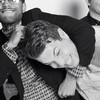
Advertisement
Kai Wiedenhofer: I was a first-semester student in mid-October 1989, so three weeks into my education, the Berlin Wall came down. I was in Cologne, and one of my professors said, “If you have time you should go immediately to Berlin.” So a few of us drove off, missed our studies, and went to Berlin for four days. It was the most interesting political event of my life. We thought, We have a free world now, no more walls, but as we have seen in [the US] over the last 20 years there's actually a renaissance for walls.What made you return to walls later in your career?
Basically, it was more forced upon me by a friend of mine I had worked with at a Swiss newspaper. He wanted to do a story about the wall they had built between Israel and the occupied Palestinian territories. After about six or seven phone calls, he basically dragged me over there. That was in 2003, and I made a book of that work for Steidl, which was published in 2007. From there, I expanded the project and went to the other places.

I think it’s a stupid concept, basically. The Berlin Wall was actually the best proof that you cannot solve a problem by building a wall. It’s counterproductive. Whatever it is—an economic problem or an ethnic or religious one—a wall will only make things worse. You can see it in Belfast, for example, where the more the people don’t know each other and don’t communicate with each other, the more people just get an image of the other side that has nothing to do with reality.
Advertisement
You can’t stay long in a place before you have to go. You drive around and you see something and then you photograph ten, maybe 15, 20 minutes tops, then you go off.

I worked in parts of Ireland in the 90s and hadn’t been back, so I thought maybe the wall would have been reduced or even dismantled. I bought a new camera in 2008 with a perspective control and shift in all directions, so I thought I’d take the camera and go back to Belfast. I discovered that they had restarted a lot of walls, they built them higher, they had built new ones. It was the opposite of what I thought would have happened.

The fall of the Berlin Wall was a very positive thing. You can see, for example, in Syria that revolutions can go badly wrong. But during the fall of the Berlin Wall, no one died. It was a very positive event and could have been a model for the rest of the world. In '89, many people thought there would be no more walls, but we were really proven wrong. So we had the logical idea to go back to the wall and put the photos on there. If we manage to put this thing up, we will have a quarter of a million people there and we won’t have to pull anybody into a museum to see it.
Advertisement

Yeah, sure. Like I say, if you want to put a nail into wood, you use a hammer not a screwdriver. It’s a basic logic, you know? I come from a craftsman family and what is a wall, basically? It’s this massive, seemingly endless thing. When you’re standing in Jerusalem and the wall is nine meters high, that’s really immense. For the exhibition, I want to transmit this endlessness of the wall and also the size.What kind of things do you hope people start talking about when they see these photographs?
Everyone has their own opinion. We made a life-size test print of one of my photos from the Mexican-American wall and put it on the Berlin Wall. A group of Americans walked by and was telling us how we can’t compare the wall in the US to the Berlin Wall. In every place you go, someone will explain to you that a certain wall was needed and it’s different from the other ones. It’s also about getting a discussion going about imposing will. There is always this talk about globalization, but if you really think about it, it’s the money that goes global, and the people who stay behind walls.

It’s a simple solution and it’s also something visual. In the USA [with the border fence], for example, voters can say, “OK, the state is doing something, because a wall is a physical thing standing somewhere." In the Arizona desert, it’s very visual. And at the same time, it also becomes a mental thing. You don’t have to be there, you don’t have to stand in Arizona and look over to Mexico. You can get a mental image about a wall when you are in New York, or Denver, or anywhere else. It’s basically a symbol people have in their minds.
Advertisement
